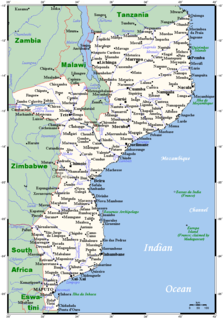
The geography of Mozambique consists mostly coastal lowlands with uplands in it's center and high plateaus in the northwest. There are also mountains in the western portion. The country is located on the east coast of southern Africa, directly west of the island of Madagascar. Mozambique has a tropical climate with two seasons, a wet season from October to March and a dry season from April to September.

Zambia is a landlocked country located in Southern Africa, to the east of Angola. It has a total area of 752,618 square kilometres, of which 9 220 km² is water.
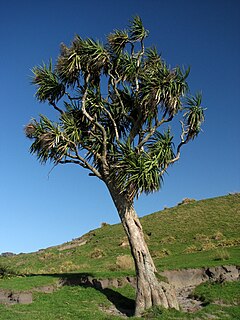
Cordyline australis, commonly known as the cabbage tree, cabbage-palm is a widely branched monocot tree endemic to New Zealand.

Brachystegia tamarindoides Benth., known as mu'unze and also as the mountain acacia is a medium-sized tree with smooth grey bark, bluish-green leaves and small creamy-white flowers that produce copious amounts of pollen and nectar. It is almost always very close to upturned umbrella shaped with a partially developed flat top, making it easy to recognise in mixed woodland. In this it differs from most of the other Brachystegia species that have variable shapes. The leaves are feathery in appearance, with around 10-12 leaflets arrayed along each leaf stalk.

Pterocarpus angolensis is a species of Pterocarpus native to southern Africa, in Angola, Mozambique, Namibia, South Africa, Swaziland, Tanzania, Zaire, Zimbabwe,and Zambia. It is a protected tree in South Africa. The name Kiaat, although Afrikaans, is sometimes used outside South Africa as well. In Zimbabwe, depending on what region you are in, it is known as Mukwa or Mubvamaropa.
A Dambo is a class of complex shallow wetlands in central, southern and eastern Africa, particularly in Zambia and Zimbabwe. They are generally found in higher rainfall flat plateau areas, and have river-like branching forms which in themselves are not very large, but combined add up to a large area. Dambos have been estimated to comprise 12.5% of the area of Zambia. Similar African words include mbuga, matoro (Mashonaland), vlei, fadama (Nigeria), and bolis ; the French bas-fond and German Spültal have also been suggested as referring to similar grassy wetlands.
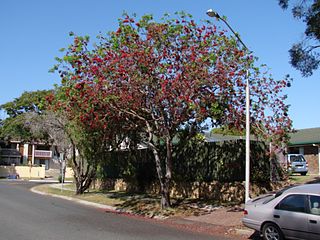
Schotia brachypetala or weeping boer-bean is a leguminous flowering tree in the family Fabaceae and the subfamily Detarioideae. The woodland tree is native to Africa south of the Zambezi River, where it occurs at middle altitudes. It is well-suited as shade or ornamental tree in warmer regions, and is consequently widely cultivated in gardens and parks. It is named for the copious nectar that drips from its flowers, which attracts various species of birds and insects. It is known by various other names, including tree fuchsia, African greenheart and African walnut.

The wildlife of Malawi is composed of the flora and fauna of the country. Malawi is a landlocked country in southeastern Africa, with Lake Malawi taking up about a third of the country's area. It has around 187 species of mammal, some 648 species of birds have been recorded in the country and around 500 species of fish, many of them endemic, are found in its lakes and rivers. About 20% of the country has been set aside as national parks and game and forest reserves.

The amethyst sunbird, also called the black sunbird, is a species of passerine bird in the Nectariniidae family. It is native to the Afrotropics, mostly south of the equator. They are commonly found in well-watered habitats, and undertake seasonal movements to visit flowering woodlands. The demise of some woodlands have impacted their numbers locally, but their range has also expanded along with the spread of wooded gardens.

The white-bellied sunbird, also known as the white-breasted sunbird, is a species of bird in the Nectariniidae family. It is found in Angola, Botswana, Democratic Republic of the Congo, Malawi, Mozambique, Namibia, South Africa, Swaziland, Tanzania, Zambia, and Zimbabwe.
The Angolan African dormouse is a species of rodent in the family Gliridae. Found in central and north Angola and western Zambia, it has been recorded from seven localities over an altitudinal range from 1,000 to 2,000 m above sea level. Its natural habitat is tropical dry forests. Although the population size is unknown, it is thought to be generally uncommon.

Parinari curatellifolia is an evergreen tropical tree of Africa, found in various kinds of deciduous woodland most frequently in poorly drained areas and inland at moderate altitudes. It is also known as mupundu or mobola plum after the fruit, which is considered tasty and causes the tree to be spared when woodland is cleared for cultivation.
The biomes and ecoregions in the ecology of Zambia are described, listed and mapped here, following the World Wildlife Fund's Global 200 classification scheme for terrestrial ecoregions, and the WWF freshwater bioregion classification for rivers, lakes and wetlands. Zambia is in the Afrotropic biogeographic realm of the scheme. Three terrestrial biomes are well represented in the country . The distribution of the biomes and ecoregions is governed mainly by the physical environment, especially climate.
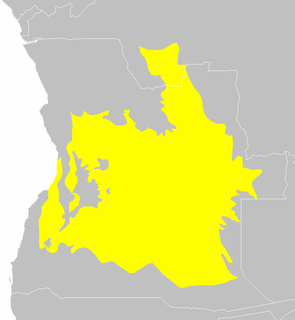
Angolan miombo woodlands cover most of central Angola and extend into the Democratic Republic of Congo. This is part of the larger miombo ecosystem that covers much of eastern and southern Africa.

The densely forested Central Zambezian miombo woodlands that cut across southern central Africa are one of the largest ecozones on the continent and home to a great variety of wildlife, including many large mammals.
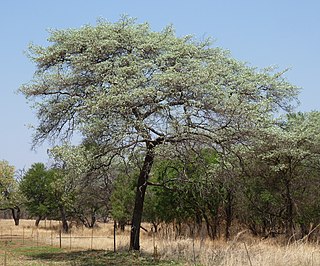
Terminalia sericea is a species of deciduous tree of the genus Terminalia that is native to southern Africa. Its common names include clusterleaf, silver cluster-leaf or silver terminalia in English, vaalboom in Afrikaans and mususu in Venda.
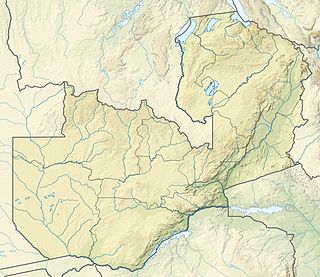
Lavushi Manda National Park is a national park in the Muchinga Province of Zambia with an area of 1,500 sq km. It is part of the Central Zambezian Miombo woodlands ecoregion. It is the 11th largest of the 20 National Parks in Zambia. The park was initially gazetted as a Game Reserve in 1941, and as a National Park in 1972.






















